Shiitake cultivation
Author: András Geösel, PhD
The shiitake mushroom and its medicinal effects
The mushroom species shiitake (Lentinula edodes (Berk.) Pegler) belongs to phylum Basidiomycetes, classis Agaricales into family Marasmiaceae (http://www.mycobank.org/BioloMICS.aspx?Table=Mycobank&Rec=29869&Fields=All).
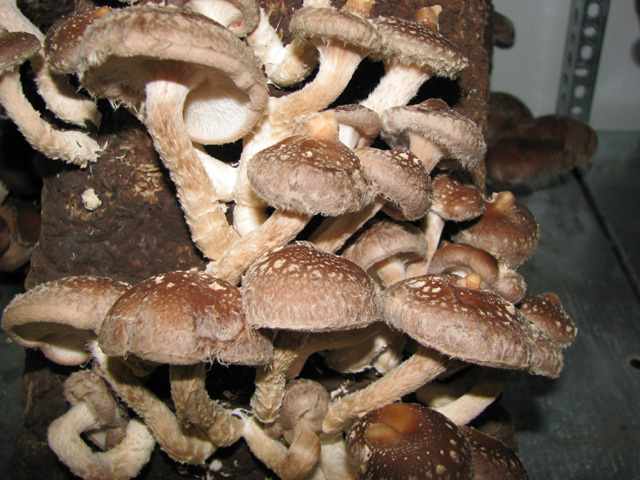
The cap is convex with diameter 6-15 cm, dark-brown coloured, covered by squamous particle of veil. The length of stipe is 3-5 cm with filamentous structure, the cultivated ones are usually curved. Hymenium is not covered by velum, both the cap’s flesh and spores are white. The vegetative mycelium on synthetic media is also whitish, depending the cultivars dense and later changes into yellowish-brownish colour. The name ’shiitake’ is derived from words ’shii’ and ’take’. ’Shii’ is the Japanese name of an evergreen tree, Castanopsis cuspidata which is an Asian tropical beech (Fagaceae) while ’take’ means mushroom. Shiitake is a common species in East-Asia, by feeding behavior is a white-rot fungus. The first written report about shiitake dates back more than 3000 years. The mushroom has a valuable and complex content and is popular in traditional eastern medicine. Shiitake has a very distinct and characeteristic odour, because of a presence a cyclic organosulfur compound molecule, lenthionine but many other alcoholic compounds are present as well. The taste of mushroom is very similar to garlic and intensity of it increasing by drying.
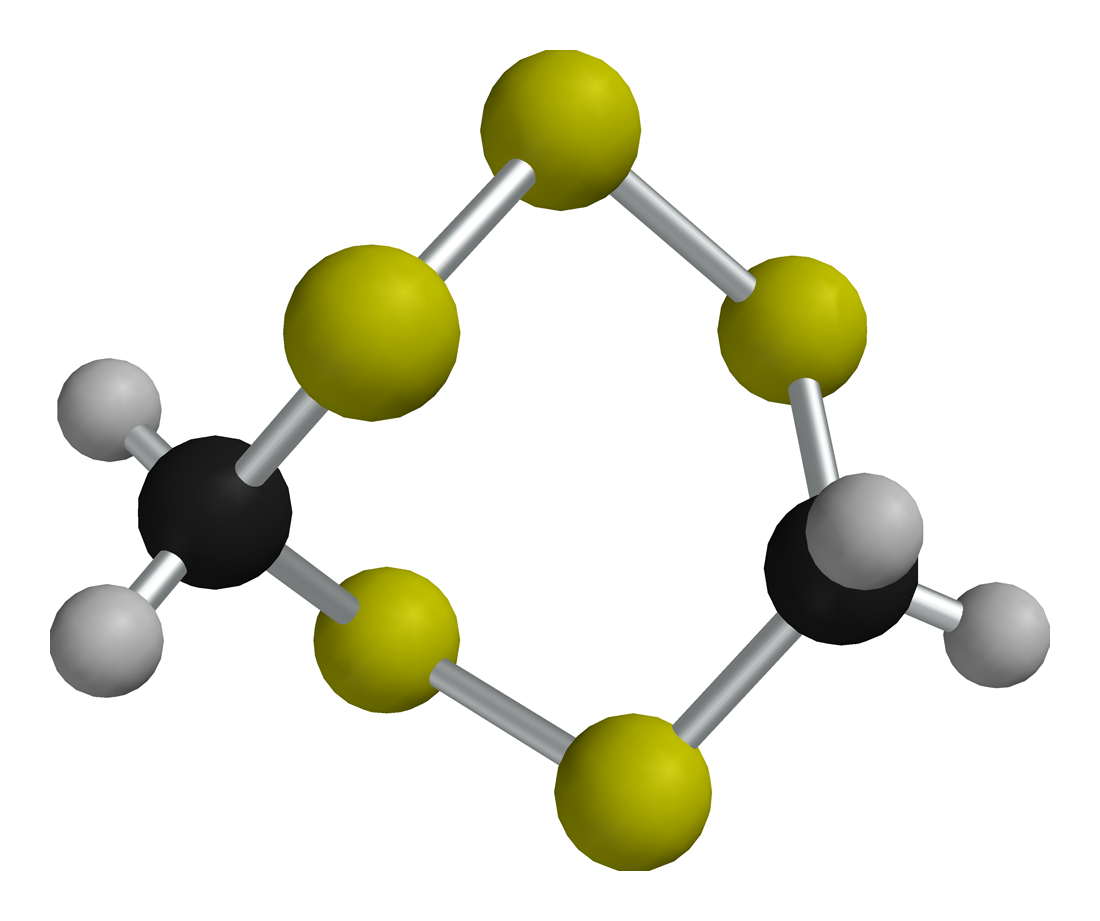
The 3-dimension model of lenthionine
The cultivation technologies are grouped by extensive and intensive methods. The extensive growing of shiitake is more than thousands years old. Nowadays the amount of cultivated shiitake is at 1-2 places on the list of cultivated species. The rapid jump in shiitake production was observed in China, where between 1985 and 1995 the amount of shiitake got ten times higher than before. Today China is the biggest producer and exporter of fresh and dries shiitake products. The advantage of this species is highlighted by its long storage potential: in fridge the quality will be the same for 1-2 weeks without any damage. Mushroom fruit bodies are having two distinct appearances, depending on cultivation technology. In Europe the dongu (winter type shiitake) is the major type, where the surface of cap is intact and has brown colour. The huagu (or shiitake flower) is the result of alternating temperature and air humidity during fruiting, therefore cap has bursts and a bit lighter colour. The price of huagu is much higher in East-Asia.
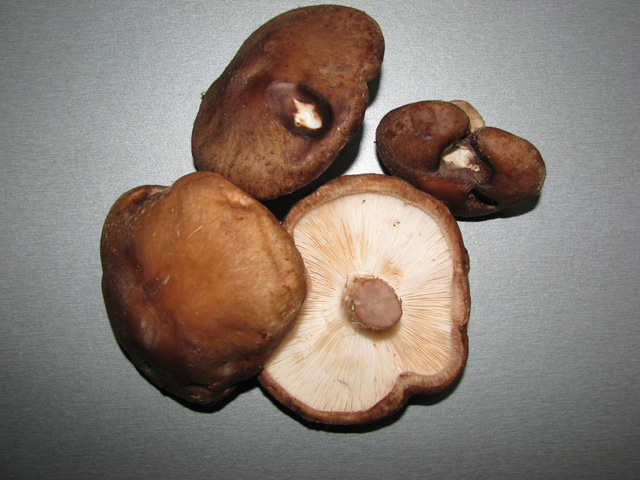
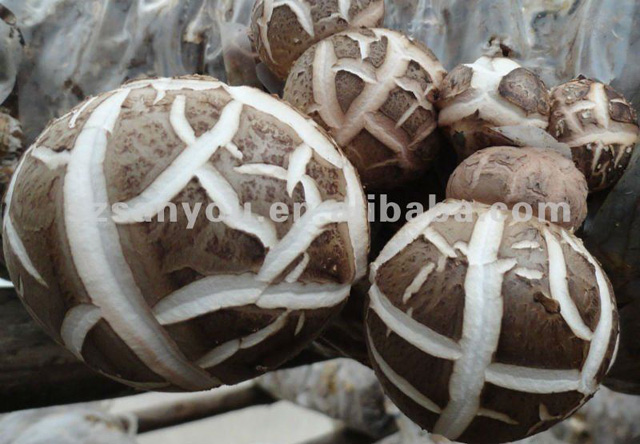
Dongu and huagu types shiitake fruit bodies
Almost endless collection of different strains and cultivars can be found on mycelia stocks from shiitake and causes problems for growers. Distinction between cultivars can be done by optimal temperature in fruiting stage. Higher temperature optimum results more thin cap flesh and worst storage conditions, its suggested in warmer climatic zone. For north and central European cultivation the intermediate cultivars are adequate. The best quality can achieved by cold-tolerant strains, that are having dark brown colour and fleshy cap.
Shiitake strains air temperature requirements during fruiting
Cold tolerant strains 8-12 °C
Intermediate strains 10-20 °C
Warm tolerant strains 20-25 °C
Strains with high tolerance in temperature 5-35 °C
Besides of fresh consumption many products can be found on market from shiitake. The most common products are dried , powdered and capsule form of mushrooms but widely used as tee or ingredient of medicinal goods.
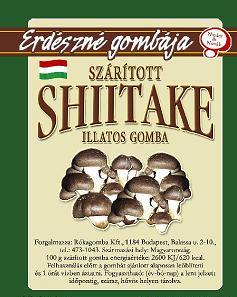
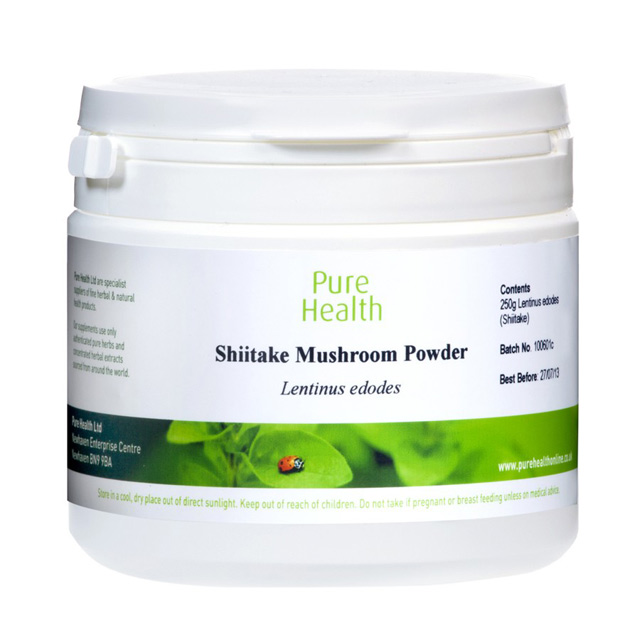
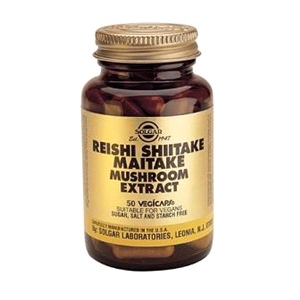
In food industry the shiitake is used for flavouring and is present in creams as well. Mushroom extraction by water or alcohol can be also found on market and a company is making beer as well from shiitake.
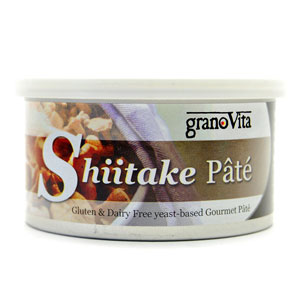

The medicinal importance of shiitake is well known for millennia and used in everyday practice in traditional eastern medicine today. Consumption of mushroom extracts is suggested in colds, pneumonia, headache but some literature data can be found about its positive effect in high blood pressure and sugar level by reducing them. The fermented mycelia (without traditional cultivation) are also in focal point of researchers. The in vitro or in vivo mycelia had positive effect on several skin diseases and was effective against rheumatic disorder and in autoimmunity.
Antitumor activity
In recent decades many researchers examined different extracts of shiitake on tumour cells, and the water extracts were effective in several cases. Sarcoma disease in mouse was tested, and the water soluble polysaccharide fractions and a protein complex from shiitake could inhibit the growing of tumour cells. The alcohol soluble fractions of shiitake are also having similar effects: the antitumor activity is related to enhancing immune system of the host and usually have no direct effect on tumour cells. Cytotoxic and cytostatic influence on human mammary adenocarcinoma was noticed by mushroom extract. A supplementary consumption of mushroom might be suggested at regeneration after a surgical intervention or traumatic affair.
Antiviral activity
Water and alcoholic extract of shiitake fruit bodies and spores were tested against HIV (Human Immunodeficiency Virus), influenza and herpes simplex virus. The antiviral effect was confirmed in most cases by activating hosts interferon. The interferons are proteins secreted by host and increase activity of macrophages. Large amount of a bioactive polysaccharide, lentinan could be detect from shiitake mushroom. In a test pure extract of lentinan could not inhibited the HIV while a complex with sulphur was effective.
Extensive cultivation technology
Extensive shiitake cultivation technologies are common by using non heat-treated substrate and usually are operating under open-air conditions. The cultivation could keep by this way 3-6 years. The extensive methods are copying the natural processes except to speed up and create more stable cultivation, the mycelia inoculated by artificial techniques. Cheap woodchips or plug spawn are used to inoculate wood logs. The wood log techniques are quite popular is Asia where the weather and substrate conditions are optimal for shiitake and good quality mushroom can harvest at reasonable price. In Europe the inoculated log techniques still stays in hobby gardens because just few mushrooms appears. The first notice about this method can dated back to Chinese Empire, where Wu San Kwung ripped up woods in forest and wind travelled spores onto them. In the XIX. century spore-suspension was used to inoculate wood log, while in XX. century the usage of spawn spread out.
How to grow shiitake at home?
The success of extensive cultivation needs a good quality wood substrate, like beech (Fagus sp.), oak (Quercus sp.), hornbeam (Carpinus sp.) but gives good results on poplar, white birch or maple and hard wood as well (chestnut, alder, ash). Wattle, pine and nut trees are usually not preferred by shiitake mycelia. The chips or sawdust from those latter might be used in intensive technologies with mixing other ingredients. The optimal cuttings the logs are at winter dormancy with water content around 50%. The logs should cut to 0,8-1,2 m long with intact bark to keep moisture in log and the optimal diameter of those are between 8-20 cm.
Optimal spawning time (inoculation with mycelia) depending on weather conditions and literature data. From mycelia growing point of view at our climate spawning at spring looks the optimum, because the hyphae colonizes the log till winter and cold temperature will not harm the mycelia. Dried logs could water content could raise back by soaking in water for 24-48 hours. Using plug spawn as inoculums is a cheap and reliable method. Holes on logs should open by drill at 10-15 cm distance from each other, exactly in the same size as plug spawn diameter. Than push the spawn into the holes and try to put 15-20 plug on a 1 m long log that is necessary for colonization. Mycelia could colonize the log quickly by longitudinal axis due to fibrovascular bundle while radial colonization needs longer time because of digestion cellulose and lignin. Wood chip spawn might be used for inoculation but needs more attention during spawning. All the mentioned methods require closing (by wax, plastic, adhesive tape) after inoculation to avoid mycelia drying and contamination.
During spawn run (colonization) should focus on optimal conditions for mycelia growing (temperature around 24-28 °C, humidity around 50-70 %, water content of log) and less optimal for pathogens. Using extensive methods the logs are simple placed on shady places without direct sunlight. To raise humidity around wood logs plastic cover or shielding is widely used. White mycelia around inoculation is a sign of successful spawning and activity of shiitake hyphae. Green mould at wood surface usually do not contaminate the inside of logs and are just present at surface: diminish it be airing. To speed up colonization place the logs into spawn run room, plastic tunnel or cave where the alternating weather could eliminate. The spawn run usually needs 6-18 months depending on substrate, temperature and shiitake cultivar. After spawn run mycelia needs incubation time for fruiting. Stand up the logs and leave space for fruit bodies around them. In natural conditions mushrooms are forming at spring and autumn, and could have better yield after soaking in cold water for 2-3 days. 10-14 days after watering primordia are forming and ready to harvest in 7-10 days. After picking the logs should have ‘rest’ for 2-3 months while no mushrooms are raising. By soaking logs 2-3 flushes can harvested in a season for 2-6 years, the total yield may achieve 15-25 % of log weight.
Intensive cultivation technology
Since XX. century intensive cultivation technologies are present in mushroom production. In Asia sawdust and woodchips was used as substrate for shiitake, and at years 1930 Europe had taken effort for developing similar techniques. The cultivation protocols used nowadays were established at 1970. The major ingredients of shiitake substrate is sawdust or woodchips mixed with supplements. The duration of a crop with intensive technologies reduced to 2-6 months and yield are much bigger compared to extensive methods. Two different substrate preparation protocols are present in practice: heat treatment or sterilized.
Shiitake cultivation from substrate till mushroom
Sterilized substrate
Major technological steps by sterilizing the subsrate:
- mixing ingredients and adding water
- filling the bags, bottles with substrate
- sterilization in autoclave
- spawning
- spawn-run, incubation and fruiting
The mass of substrate should be sawdust or woodchips derived from tree species like extensive methods. Particles from wood should be at similar in size around 2-4 mm, clean and free from dust because too small particle result poor aeration and slow colonization. Several recipes suggest straw adding to substrate that results good structure and better spawn-run.
Home made straw cutting machine
To increase nitrogen concentration in substrate additives or supplements are necessary for shorter crop. The local agricultural by-products, like cooked wheat, bran, semolina, soybean, corncob etc. are usually proper supplements in Europe. In other continent rice-bran, coffee pulp, sugarcane bagasse are mixed into substrate. Hungarian results showed that artificial supplements - that are used in white button mushroom cultivation - raise the yield on straw. The ratio of supplements is depending on wood or straw quality, season of year (less at summer, more at winter) and composition of the additives. In general, the amount of supplements is around 5-25% but the growers are not so open to tell their recipes and using their own protocols. The supplements reduce the spawn-run time and have positive effect on yield, but the quality of mushrooms is not so definite and the risk of contamination is also higher. Shiitake mycelia secrets digestive enzymes a bit less activity and amount than oyster, therefore the total crop is usually take longer time. The optimal carbon:nitrogen (C:N) ratio by shiitake is 25:1 during spawn-run, but for fruiting the amount of carbon should concentrate and achieve 35-40:1 C:N rate. Carbon is originated from cellulose, lignin and other simplex and complex carbohydrates present in straw or wood explorated by mycelia. A higher nitrogen concentration reduces the spawn-run time, but results poor quality fruit bodies. During mixing the substrate 1-2% gypsum or calcium-carbonate should add to raise pH level and have better structure. After weighting the ingredients a blender or concrete mixer could use.
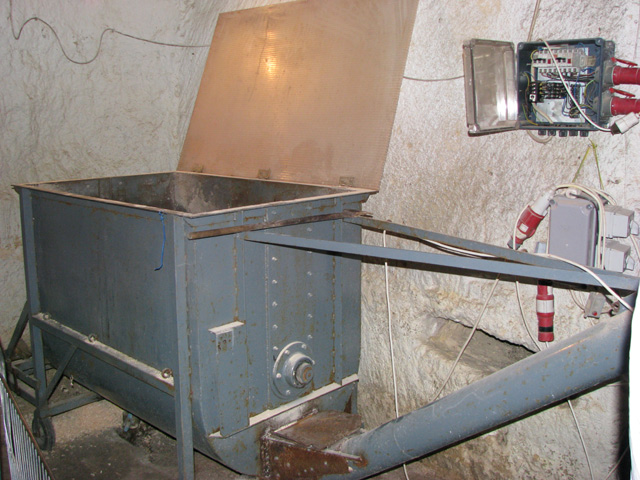
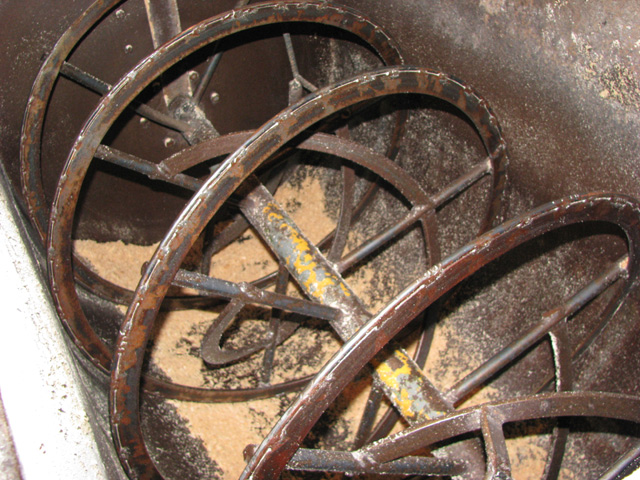
Substrate blender
Before or during mixing water is added to the substrate until it reaches 60-65%. Less water results slow spawn-run and poor yield, in addition, the artificial watering has some trouble because of the presence of hydrophobins in substrate. To the wet substrate the gypsum or calcium-carbonate could be added (adding calcium-carbonate to adjust pH is suggested by many literatures, while others state, it “slows” the hyphae). The optimal pH value range for shiitake is variable by recipes. The vegetative mycelia on synthetic media grows properly on pH=3-7. For filling bags pH=5,5-6,5 seems optimal and the digestion and excreted acids move this range to acidic, and for fruiting pH=3,5-4,5 is the optimal.
Than 1-3 kg substrate is filled into polypropylene or polyethylene bags, while several farms using plastic bottles for holding substrate. The bags should have a breathable path or a mouth closed with paper or other ‘breathable’ material for gas-changes. The substrates should be autoclaved immediately after filling to prevent fermentation. The slow colonization speed of shiitake needs substrate that is absolutely free from any competitive fungus or bacteria. Depending on sizes of substrates 2-4 hours long sterilization is necessary at 121-128 °C.
After cooling below 30 °C in a laminar box or a pressurized room inoculation by grain or plug spawn is next technological step.
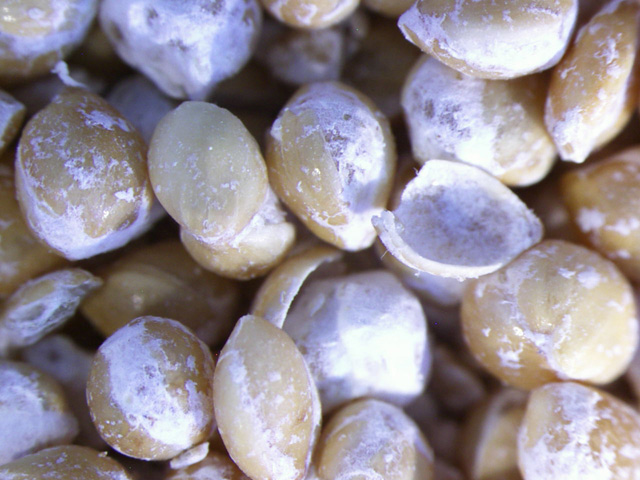
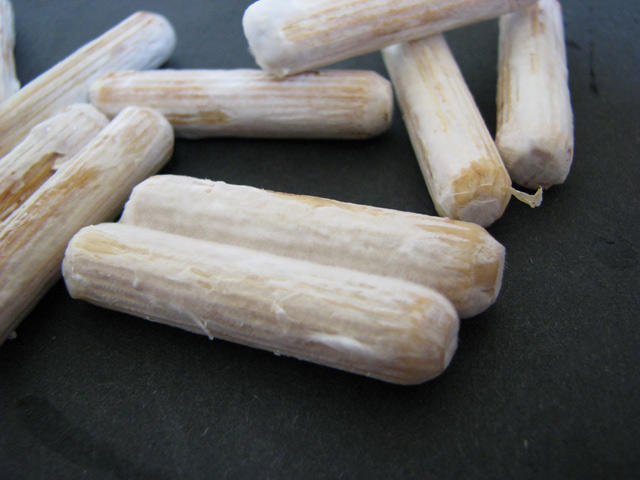
Grain spawn on millet and plug spawn colonized by shiitake
The advantage of grain spawn is deriving from two fact: to mix it into media is quite simple and could serve as supplements. Long plug spawn was used for years, but heterogeneous colonization was the result. The amount of grain spawn is around 1-5% depending of substrate and supplements. If contamination appears on surface the all bag/bottle should remove from spawn-run. The substrate preparation by sterilization needs proper machines and the costs are extreme high, therefore the usage of it is limited for only several growers.
Substrate preparation by pasteurization
The researchers are taking many efforts to find cheap methods for preparing shiitake substrate. Protocols from oyster substrate preparation (dry and wet heat-treatment) are under process to introduce in shiitake cultivation. The ingredients are mainly similar as sterilization process, woodchips, sawdust and straw are the major parts while supplements is not necessary in every routine. After mixing the raw materials pasteurization is the next step of technology. The length and temperature differs by each recipe, between 65-100 °C for 4-24 hour can be found in literature. The pasteurization will not inactivate all pathogens, especially infection of green mould (Trichoderma sp.) risk is high. High nitrogen concentration serves fast spread of green mould. After the heat treatment the spawning of substrate by grain is common (5-10 % net weight), from hygienic point of view it would suggest to spawn in pressurized conditions. The spawned substrate than filled into bags, that might be bigger than sterile technology (because of less supplement ratio, the temperature will not raise as high as possible) therefore 5-20 kg bags can prepared. Bags could be perforate before filling for gas exchange and give the necessary amount of O2 for intensively growing shiitake hyphae.
Cultivation of shiitake
Shiitake crop is usually takes longer time than other mushrooms and requires patient from grower. From spawn-run till pinning the mycelia develop, that should known for successful cultivation. After spawning the exo-enzymes from mycelia digest the organic matter of substrate and the white mycelia colonize the substrate. In this phase bags, bottles should place on shelves or floors in growing room.
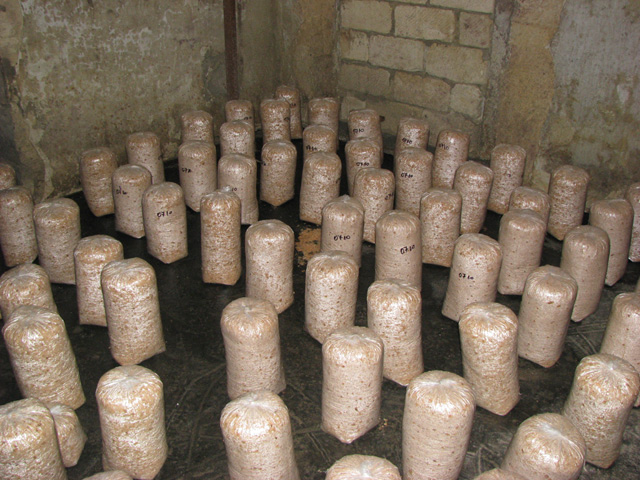
Shiitake spawn-run in a mushroom cave
After spawn-run the bags change colour and will have bright whitish colour than get harder structure. In the hardening stage – that includes several changes - the mycelia adsorbs and accumulate nutrient necessary for fruiting:
- At substrate’s surface thin, whitish mycelia cover layer develop.
- The outer mycelia will more hard and small bumps appear at surface. That bumps can develop into fruit bodies, but many of them will never grow.
- In pigmentation phase the whitish mycelia changes into brownish colour, the bags should open in this stage. The increasing concentration of fresh air has positive influence on colour.
- The surface of substrate gets more hard, dry structure and even dark colour, therefore the plastic bag can completely remove from substrate. The bags inside usually contains 70-75 % water that is optimal for fruiting.
- At the end of ‘ripening’ the mycelia utilizes the nutrient and primordial develop into fruit bodies. Certainly, the mentioned stages are not clearly separated phases, it is a biological process.
Shiitake cultivation in Hungary (in Hungarian)
The required environmental conditions are different at each cultivation steps, but many discrepancy can found in literature. It is in conjunction with every authors and growers at spawn run the substrate temperature should be around 25-27 °C. The relative humidity is not so important, because mycelia is within the bag and loose not too much water therefore 50-90 % is enough with low aeration. During spawn run light is not necessary, the CO2 in bags can be above than 5.000-15.000 ppm. Alternating day-night temperature and higher CO2 concentration can help bump formation. The colour changes can done in bags or without bags – the differences is depending from growers. For having nice primordia formation 20-25 °C in bags with 70-80 % humidity and lower carbon-dioxide (2.000-3.000 ppm) level is necessary. The early bag opening may have abnormal fruit body formation, while later may cause less mushroom. Spawn run duration is usually 3-6 weeks, the induction could be also 3-6 weeks. According to several growers fruiting can achieved on 50-100 days after spawning. At fruiting bags are placed in place with moderately controlled environmental conditions.

Hanged substrate in fruit body development phase
Appearance the number of primordia may raise by changes in environment. Mainly one factor is enough for fruiting, but usage more than one increase number of small mushrooms:
- lower temperature, or higher deviation between day and night temperature
- watering the surface of soaking the blocks
- alternating humidity
- decreasing CO2 level (below 1.500 ppm)
- physical shock (shaking, patting, watering inside of block
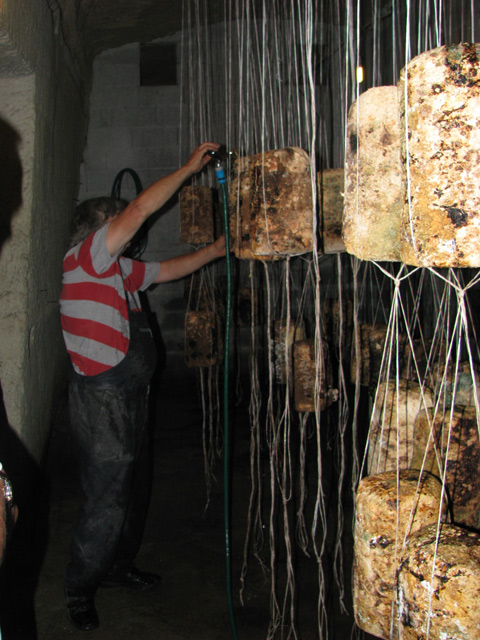
Watering shiitake in fruiting by pushing hose into the block (outer layer of substrate do not adsorb enough water before first flush)
In fruit body development phase air temperature should keep at 16-18 °C, while humidity around 80-90 %. For having good quality mushrooms and cap-stalk formation, since primordia stage 1000 lux light is also necessary, that might in cave achieve by artificial light. If CO2 level raises above 1.000 ppm cap remain small and stalk elongate. Several growers soaking block before first flush, while others just after. The substrates browned within bag usually do not require soaking, because there is enough water capacity in substrate. After cooling the primordia develops onto picking stage in 5-10 days if light and temperature is satisfactory. The optimal temperature is related to cultivars, but in general lower temperature results better quality and longer storage potential, while cause slow development. Picking by hand is obligatory, by a firm twist from substrate until the mushroom cap is not completely flat. Never cut the mushroom from the substrate in first flush because it opens an entry for diseases. The lower stalk part of picked mushroom should cut by a knife. After first flush mycelia needs 2-3 weeks ‘dormancy’ for preparing second flush. For induction soaking in water for several hours or use hose to irrigate inside the blocks. 5-10 days after watering the second flush is coming that are ready for harvest within a week. During two or three flushes 20-25 kg fresh mushroom might be picked from 100 kg substrate, usually the first yield is the top (around 50-80 % from total). Freshly picked mushroom can be stored in a fridge for several weeks and easy to transport. The most simple processing form of mushroom is slicing and drying and sell it as natural flavour or create powder from it.
Test your knowledge!
1. What kind of fruit body forms of shiitake are known?
2. What are the major technological steps of cultivation?
3. What are the substrate preparation methods?
4. Describe the extensive methods of shiitake growing!
5. What are the common ingredients of intensively grown shiitake substrates?
6. Set out at least five shiitake products!
References
Chang, S.T., Miles, P.G. (2004): Mushroom Cultivation, Nutritional Value, Medicinái Effect, and Environmental Impact. CRC Press Boca Raton, London, New York, Washington.
Chen, A.W. (2005): Shiitake bag cultivation. In: Mushroom Growers Handbook 1. Oyster Mushroom Cultivation. Mush World, Seoul, 88-106.
Chen, A.W. (2005): What is shiitake? In: Mushroom Growers Handbook 1. Oyster Mushroom Cultivation. Mush World, Seoul, 3-16.
Fan, L., Pan, H., Wu, Y., Choi, K.W. (2005): Shiitake bag cultivation in China. In: Mushroom Growers Handbook 2. Shiitake Cultivation. MushWorld, Seoul, 144-156.
Győrfi, J. (szerk)(2012): Gombabiológia, gombatermesztés. Mezőgazda Kiadó, Budapest.
Hobbs, C. R. (2000): Medicinal value of Lentinus edodes (Berk.) Sing. (Agaricomycetideae). A literature review. International Journal of Medicinal Mushrooms, 2, ( 4): 287-302.
Israilides, C., Kletsas, D., Arapoglou, D., Philippoussis, A., Pratsinis, H., Ebringerová, A., Hríbalová, V., Harding, S.E. (2008): In vitro cytostatic and immunomodulatory properties of the medicinal mushroom Lentinula edodes. Phytomedicine, (6-7): 512-519.
Levanon, D., Rothschild, N., Danai, O., Masaphy, S. (1993): Bulk treatment of substrate for the cultivation of shiitake mushrooms Lentinus edodes on straw. Bioresource Technology, 45, ( 1): 63-64.
Oei, P. (2003): Mushroom cultivation. Backhuy Publishers, Leiden, The Netherlands.
Royse, D., Shen, Q. (2005): Shiitake Bag Cultivation in the U.S. In: Mushroom Growers Handbook 2. Shiitake Cultivation. MushWorld, Seoul, 106-108.
Stamets, P. (2000): Growing Gourmet and Medicinal Mushrooms. Ten Speed Press, Toronto, Kanada.
Szili, I. (2008): Gombatermesztők könyve. Mezőgazda Kiadó, Budapest.
Vetter, J. (2001): A shiitake gomba (Lentinula edodes) beltartalmáról. Magyar Gomba, 5, ( 17): 25-28.
Zhong, M., Liu, B., Liu, Y., Wang, X., Li, X., Liu, L., Ning, A., Cao, J., Huang, M. (2012): The antitumor activities of Lentinula edodes C91-3 mycelia fermentation protein on S180 (Mouse sarcoma cell) in vivo and in vitro. Journal of Medicinal Plants Research, 6, (12): 2488-2492.
Pictures

